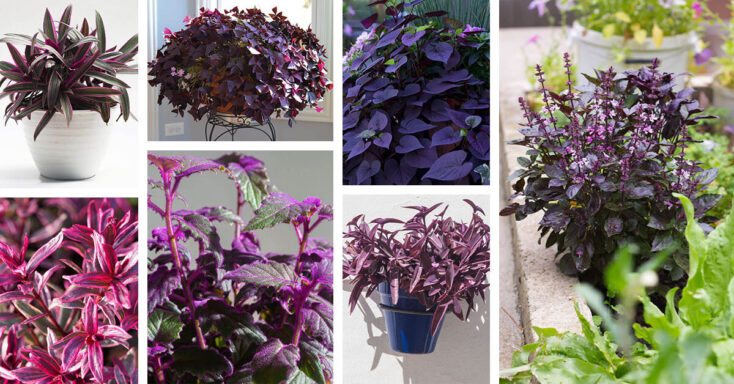When it comes to showy ornamentals, big blooms always seem to get the most love, from peonies and marigolds to roses and chrysanthemums. However, there’s a lot to be said for plants with showy foliage. For one thing, foliage lasts a lot longer than even the most long-lived flowers, so you can enjoy the color year-round. For another, leaves offer an incredible range of patterns that you’re unlikely to find on even the showiest flowers, from stripes and polka dots to intricate multicolored marbling.
Some of the most striking foliage in the plant kingdom is the deep purple color produced by anthocyanins in the leaves of many tropical plants. These chemicals protect plants from damaging ultraviolet light, as well as herbivory, and range from vivid magenta to a maroon so deep it’s nearly black. Many of these plants are too tender to survive outside of the tropics, but they make great container plants or houseplants.
Below you’ll find 19 of the richest, most vibrant purple-leaved houseplants available. From lush, sprawling vines to compact succulents, there’s a whole universe of houseplants out there that have more color and beauty in a single leaf than many perennials have in a whole season’s worth of blooms! You’ll also learn how to keep your purple houseplants happy, how to maximize their color, and why so many plants have purple leaves in the first place. If purple is your color (and let’s be honest, purple is everyone’s color!), you won’t want to miss these plants!
Key Takeaways
- Most purple foliage is caused by anthocyanins, a family of molecules that serve a few different functions in plants. Their primary function in leaves is to protect the foliage from two main dangers: excessive light and heat, and herbivory (i.e., being eaten). Because they are complementary in color to green leaves, they reflect a great deal of the red light that plants use for photosynthesis, which is useful if the plant is in an exposed location where too much sunlight might damage the chloroplasts. They also “camouflage” the plant from herbivores that are attracted to the color green, and can be distasteful as well.
- Since purple leaves are usually produced in response to high light, it stands to reason that most purple plants will be most purple in full sun. This is true for many of the plants on this list, but for some, even the anthocyanins in their leaves won’t provide sufficient protection from direct sunlight. These plants will do best in bright but indirect or filtered light, or with some afternoon shade.
- If you grow lights with your houseplants, keep in mind that the wavelength of light has a big impact on the color of your plants. Higher wavelength light, like ultraviolet and blue light, has higher energy and thus stimulates anthocyanin production more efficiently than lower wavelengths like red or green light. LEDs generally produce the most high-wavelength light.
- Temperature is also important: many plants produce more anthocyanins at low temperatures than at high temperatures. The optimal combination for most purple plants is low temperature and high light.
- That said, purple coloring can sometimes indicate pathology, especially in plants that don’t normally have purple coloring. Usually, it’s caused by a lack of phosphorus, and is especially common in tomato plants. Fortunately, this is easily remedied with fertilizer — but if your in-ground plants regularly develop purple spots, you may need to amend your soil.
19 Purple Leaf Indoor Plants for a Touch of Glamour
1. Persian Shield (Strobilanthes dyeriana)
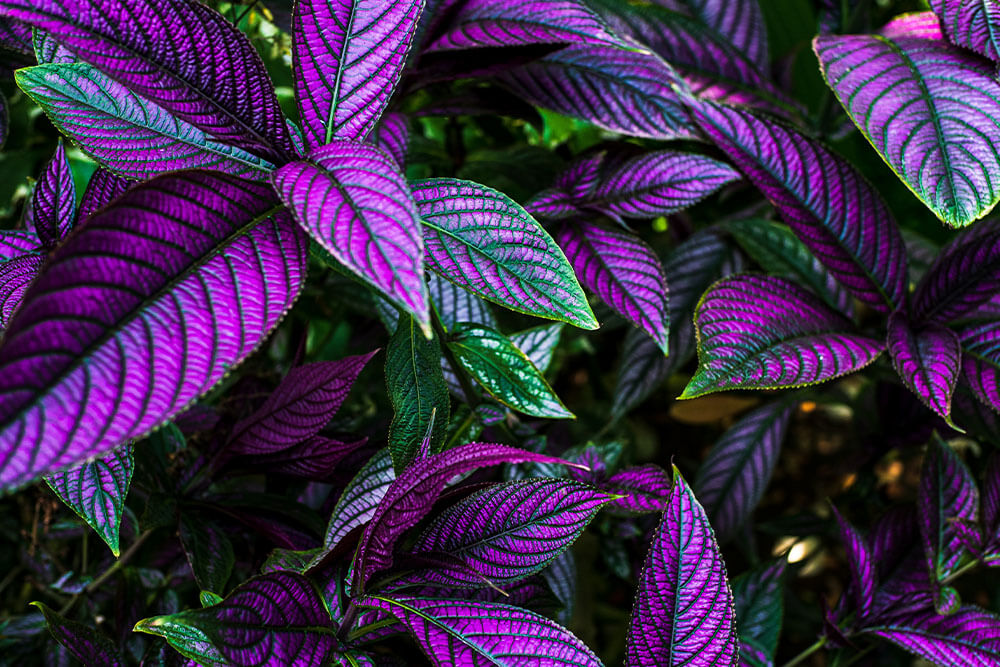
Persian shield has been a popular ornamental since the Victorian era, but there’s nothing old-fashioned about its appeal. In fact, of all the plants on this list, Persian shield might just have the most beautiful foliage. “Purple” doesn’t even do it justice: the lilac and deep mauve contrasts strikingly with the dark green veins, giving the plant a romantic, nocturnal appearance that’s eerily beautiful.
Persian shields can be grown outdoors in zones 10 & 11, but they’re easy to keep as container plants pretty much anywhere! They’re easy to care for and don’t require much maintenance, needing only a couple of hours of direct sunlight and consistently moist soil (put the plant in a saucer full of rocks and water). If it starts to get too big, you can pinch the offending stems, but most indoor Persian shields don’t get very large.
2. Velvet Plant (Gynura aurantiaca)
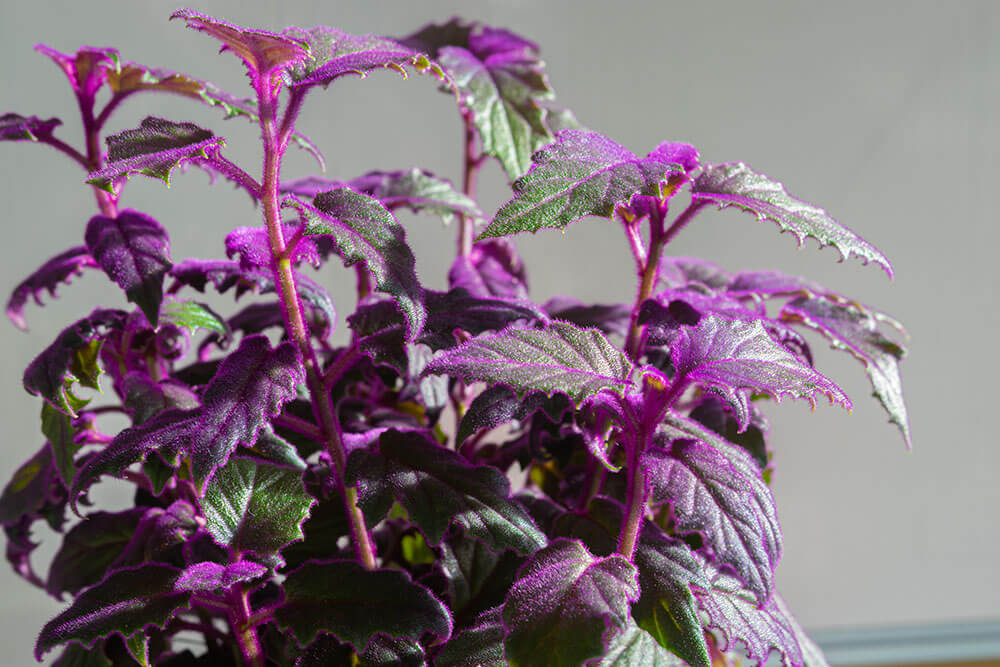
Velvet plant is native to Java, and its leaves aren’t purple, they’re green (or variegated green and white). However, the foliage is covered in bright purple hairs, giving the plant an incredibly dimensional, two-toned appearance. The foliage is most vibrant when it’s grown in bright but filtered light, and it’s quite low-maintenance if placed in the right spot.
Velvet plants have a tendency to legginess, but spraying them with a growth regulator like Florel will encourage a more compact growth habit. Treatment with a growth regulator has the added benefit of suppressing flowering – which is a good thing, because the flowers have a strong and unpleasant smell. Fortunately, indoor plants rarely bloom anyway – another good reason to keep them out of direct sunlight!
3. Purple Heart (Tradescantia pallida ‘Purpurea’)
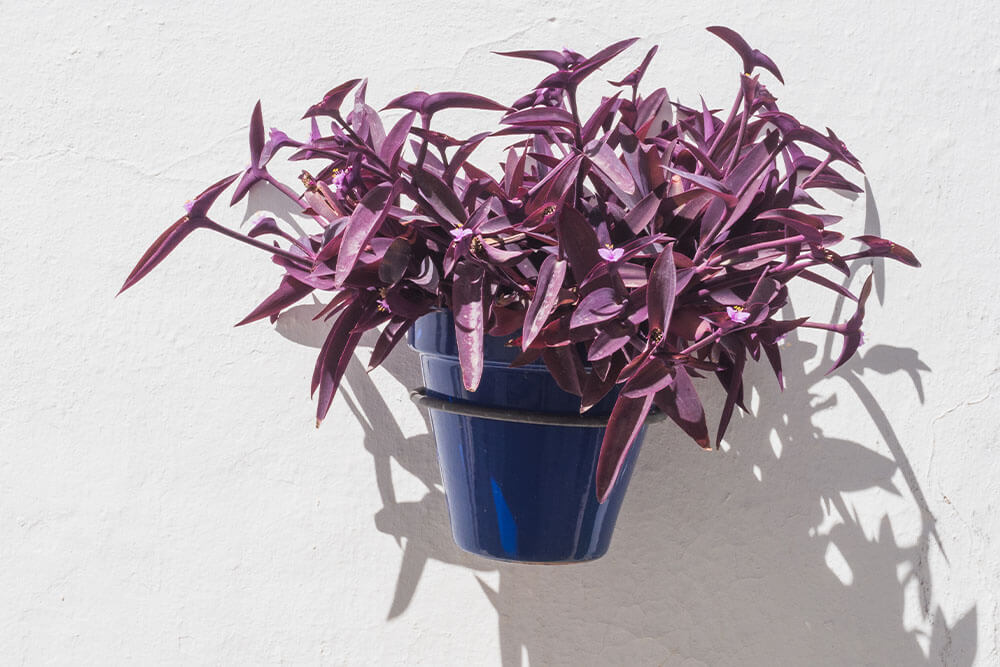
Purple heart is a tough, succulent groundcover in the same family as inch plants and geo plants (covered elsewhere on this list), and it’s often used in outdoor borders for its attractive deep purple foliage. It also makes a lovely houseplant, cascading over the edges of its container like a purple waterfall. In summer, it also produces small pink flowers that perfectly complement the foliage.
When grown as a houseplant, purple heart likes full sun – and if you like purple foliage, you will too, because plants grown in shade tend to be greener and not as deep purple. Other than this, they’re extremely low-maintenance. If you find your purple heart is starting to get too big, you can clip the plant without hurting it, but don’t just toss out the clipped stems because propagating new plants from cuttings is a breeze!
4. Purple Basil (Ocimum basilicum var. purpurascens)
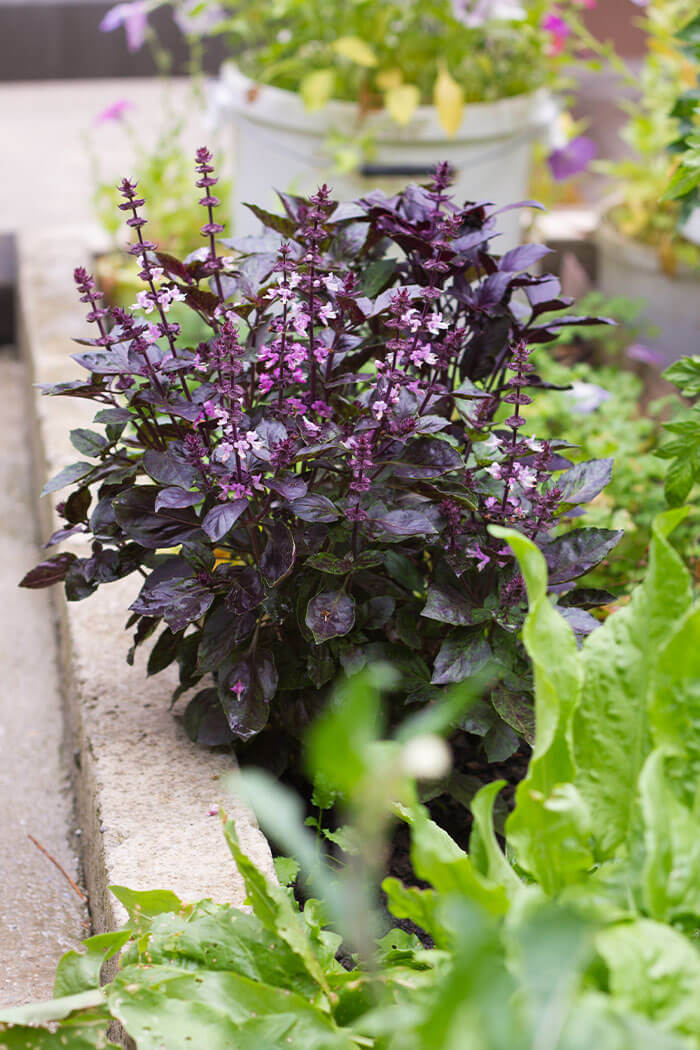
You might not think of basil as an ornamental plant, but the deep purple leaves of purple basil are so beautiful you might not want to eat them! (You can, by the way: purple basil is prized for its deep, complex flavor, with notes of cinnamon and anise.) Purple basil is actually the same species as ordinary garden basil, and there are several different varieties with purple leaves. The two most popular are Osmin purple, which is the original purple basil, and ‘Purple ruffles,’ which has ruffled and serrated leaves.
Basil is well-known for being one of the easiest garden plants to care for, and purple basil is just as easy to grow as any other variety. Keep your plants in a sunny window and water occasionally, and they’ll reward you by doing double duty: houseplants that taste as good as they look!
5. False Shamrock (Oxalis triangularis)
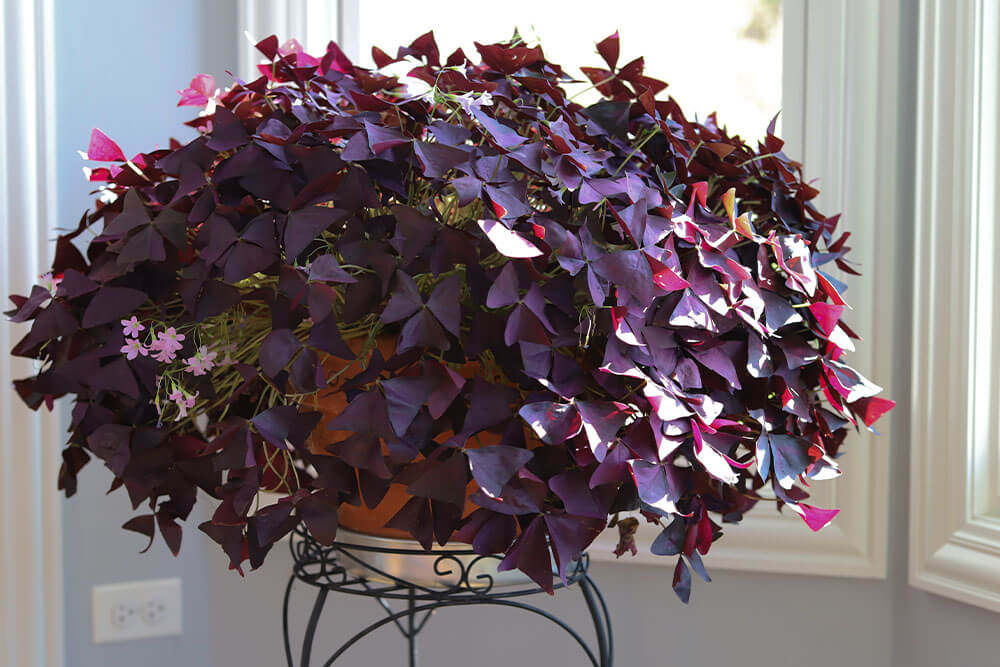
Oxalis, often collectively referred to as “wood sorrels,” is a genus of flowering plants with distinctive clover-like leaves and diminutive five-petaled flowers. Many species are popular garden plants, but none of them is as eye-catching as that of false shamrock. The giant, purple leaves fold up at night, after being disturbed, and in direct sunlight (the plant’s way of asking for some shade), as do its delicate white-to-purple flowers, which are a whimsical contrast to the gigantic foliage.
South of zone 7, false shamrock makes a lovely outdoor perennial, but it also takes well to containers. An east-facing window with some direct morning sunlight is a perfect spot for this plant, which is fairly hardy and drought-tolerant but will go dormant if too hot or dry. Not to worry: once soil and light conditions are back to optimum, the plant will come back from the roots.
6. Neoregelia, Air Plant (Neoregelia ‘Purple Passion’)
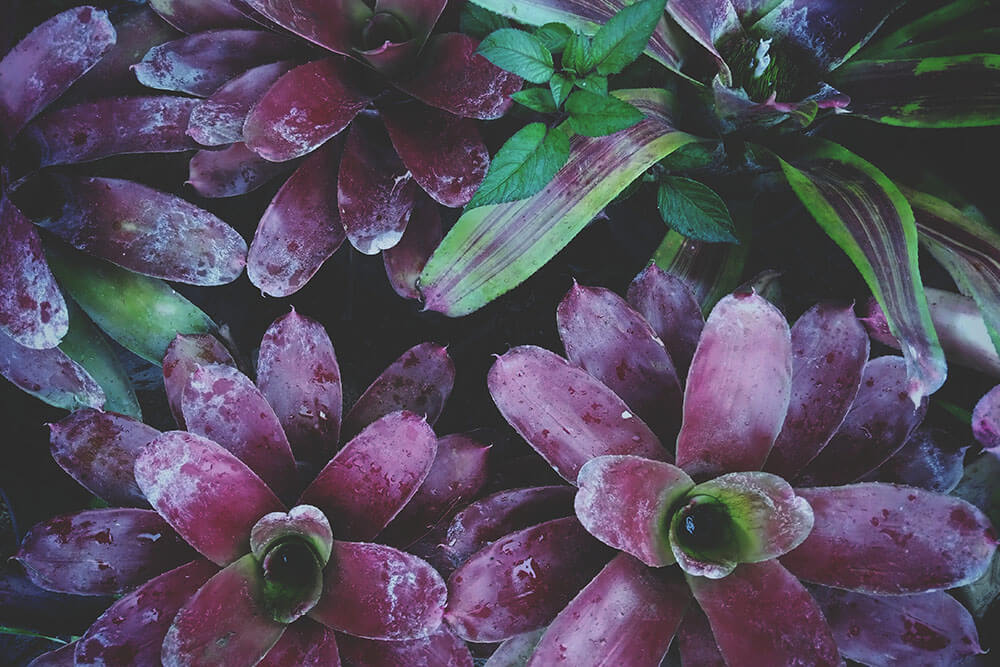
Neoregelia is an epiphyte, meaning it grows on other plants (or rocks) rather than in soil. Epiphytic houseplants are often called “air plants” because they get all their nutrition from the air and rainwater! Most neoregelias have large, yucca-like leaves that turn red or purple at the base, but the ‘Purple Passion’ variety is a striking purple and green all over, with a vibrant purple center.
Like most epiphytes, neoregelia does best in bright indirect light and a soil-less medium — but since it doesn’t get any nutrients from the soil, any potting mix will work fine. The important thing is to avoid overwatering — and in fact you don’t have to water the soil at all! In the wild, these plants use the rainwater in the cup-like center of the plant, so just top up your plant with clean water (rainwater is best) and change it regularly to avoid bacterial growth.
7. Coleus (Coleus spp.)
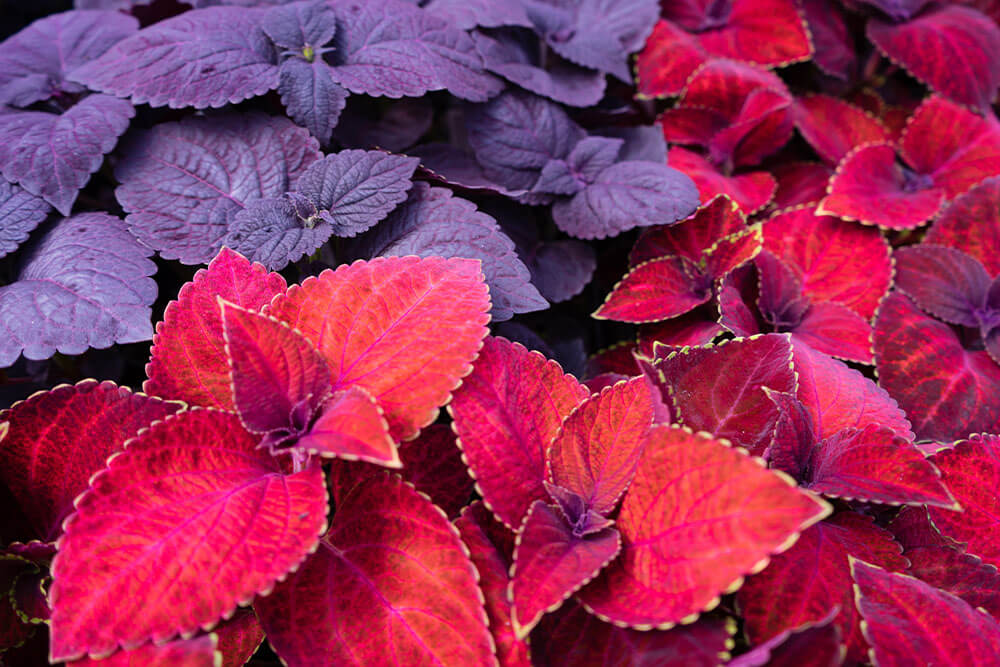
In most parts of the country, coleus is grown as an annual, because its stunning purple foliage grows extremely quickly, but is quite frost-tender. However, you can grow these plants they way they were meant to grow – as perennials – indoors, in containers, as unique and eye-catching houseplants.
Coleus has been grown for centuries for its vibrantly colored and patterned foliage, and countless varieties in every shade of red, pink, and purple – from monochrome varieties like ‘Amethyst’ and ‘Black Beauty’ to the high-contrast greens and violets of ‘Felix’ and ‘Giant Fantasy.’ Like most plants on this list, coleus develops the richest colors in bright, indirect or filtered light, and is otherwise quite easy to care for.
8. Rex Begonia (Begonia rex-cultorum)
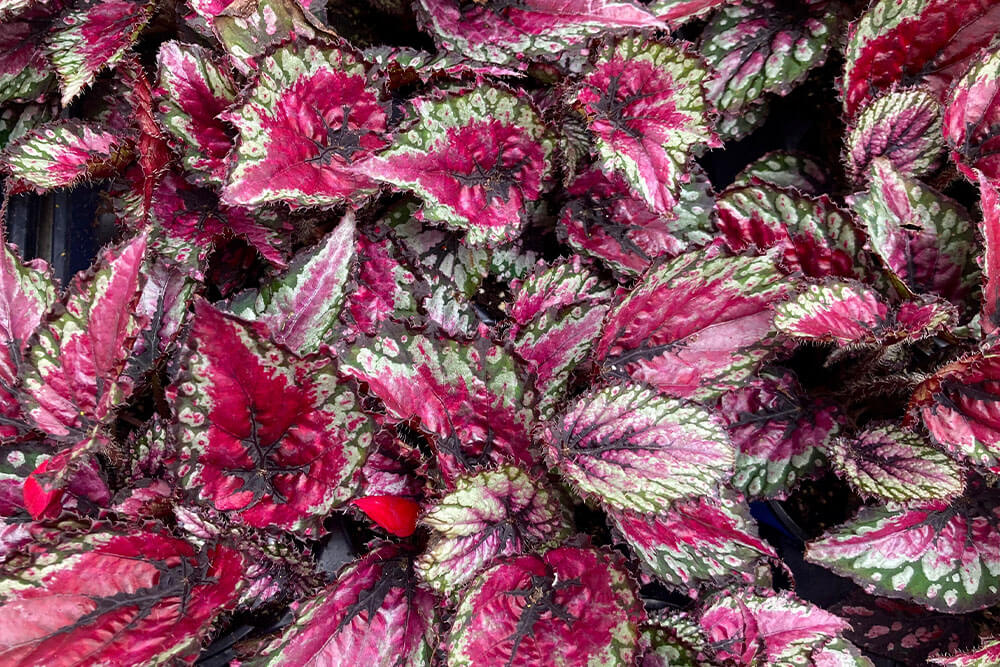
Begonias are well-known for producing incredibly rich, varied colors of foliage that make them look much harder to grow than they really are. Because of their tremendous beauty combined with their ease of growth, they’re some of the most popular houseplants in the world, and hundreds of unique varieties are available in every shade and pattern. ‘Purple Spec’ and ‘Purple Rain’ are a couple of the most beautiful purple varieties, but there are many, many more!
Begonias are heat- and humidity-loving plants, so if grown as houseplants make sure their soil stays consistently moist (but not wet!) by placing them in a tray full of small pebbles and water. Bright, indirect light gives the best colors, but too much direct sunlight will scorch their leaves, so if they are by a south- or west-facing window, consider covering with a sheer curtain in the afternoon.
9. Fringe flower (Loropetalum)
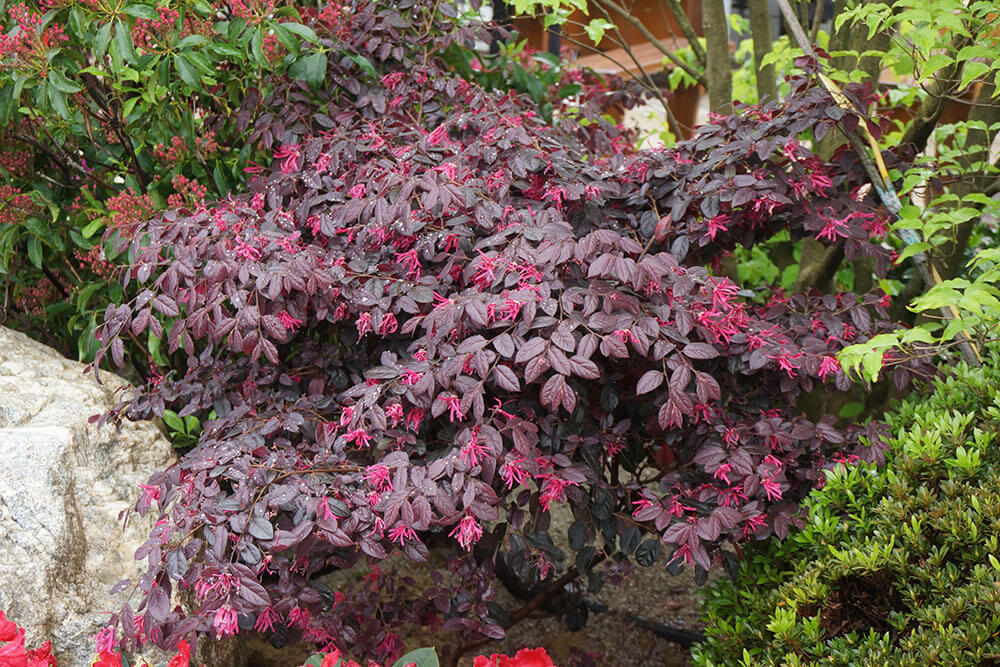
Fringe flower is a beautiful evergreen shrub, although “evergreen” isn’t quite the right word for the plum and maroon foliage…ever-purple, maybe? Whatever you call it, fringe flower makes a lovely container plant, though it’s not often grown as a houseplant because of its light requirements. If you have a big south-facing window, your fringe flower will likely be happy indoors, but you can also keep it outside in spring and summer, bringing it in when temperatures start to drop.
Most fringe flower varieties — and there are a lot of them! — have reddish-to-purple leaves, but a few stand out: ‘Purple Diamond,’ which matches deep purple foliage with bright pink flowers, and ‘Purple Pixie,’ a dwarf ‘Purple Diamond’ that’s ideal for containers. Fringe flower, being a full-sun plant, is a bit thirstier than your average houseplant during the growing season, and you may have to water twice a week or more in spring and summer — but when winter rolls around, it’ll do fine with weekly watering or less.
10. Woodland Spurge (Euphorbia amygdaloides var. purpurea)
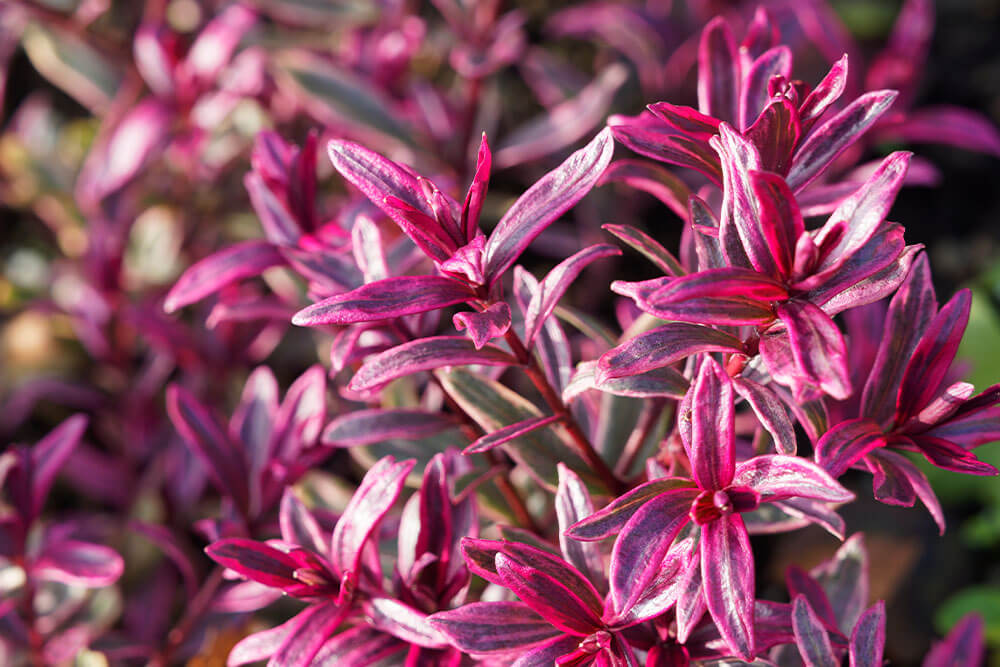
Woodland spurge is a paradoxical plant: whereas most ornamentals have green foliage and colorful blooms, all its color is in its leaves, while its flowers are a perfectly ordinary yellow-green. In fact, you might be alarmed to see the flowers, thinking, “did my spurge just run out of purple?” Don’t worry: it’s completely natural! Woodland spurge comes in a wide range of colors (though the flowers are always green); the purpurea variety boasts deep-maroon succulent leaves that don’t look much like any other ornamental.
Woodland spurge is one of the comparatively few ornamentals that thrives in dry shade, so it’s often planted under oak trees, where most other plants can’t grow. Then again, its striking foliage and shade tolerance also make it a super-low-maintenance houseplant! Pot it in a cactus potting mix, put it in a spot with some morning sun, and enjoy its strikingly colored and textured foliage year-round!
11. Waffle Plant (Strobilanthes alternata)
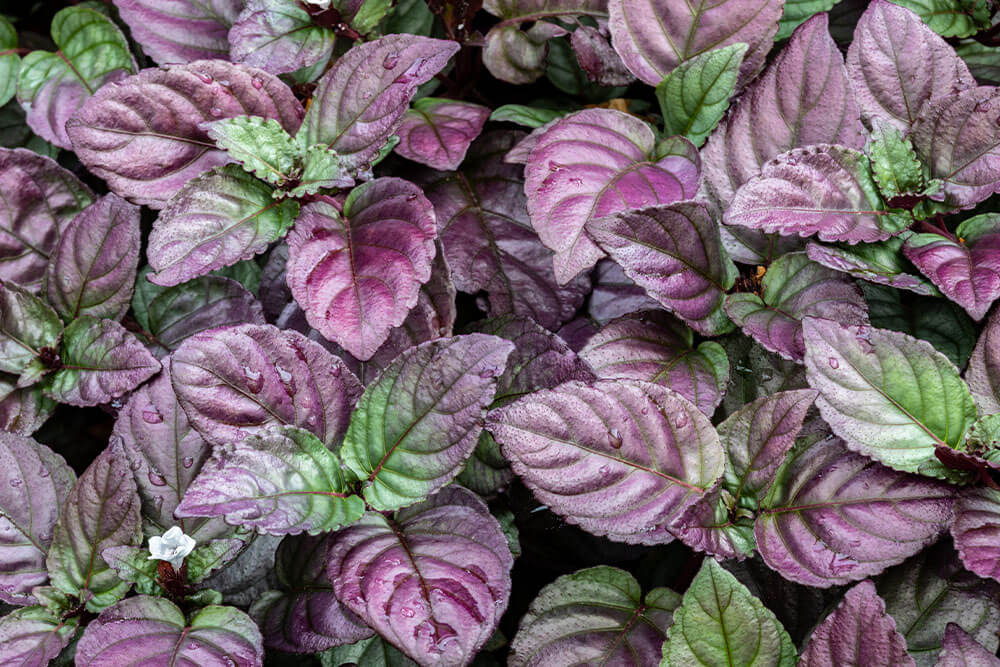
If you’re the kind of reader who pays attention to scientific names, you probably noticed that the waffle plant is in the same genus as the Persian shield. In fact, there are over 300 species of Strobilanthes, but only a few are cultivated as houseplants. Waffle plant, like Persian shield, has rich lilac foliage with contrasting dark green veins – but unlike Persian shield, it can’t really be grown outdoors anywhere in the US, as it will die when temperatures drop below 50° F.
Fortunately, it makes a great houseplant, and bright indirect light will maximize the purple color of the foliage (but direct sunlight can scorch the leaves). Not all waffle plants have the characteristic crinkled foliage, however: the ‘Exotica’ variety has the waffle-iest leaves (as well as the purple-est). To encourage a bushier, more compact shape, pinch off the stems just above where new leaves emerge: this will cause the plant to focus growth on leaves instead of stems.
12. Purple Sweet Potato (Ipomoea batatas ‘Sweet Caroline Sweetheart Purple’)
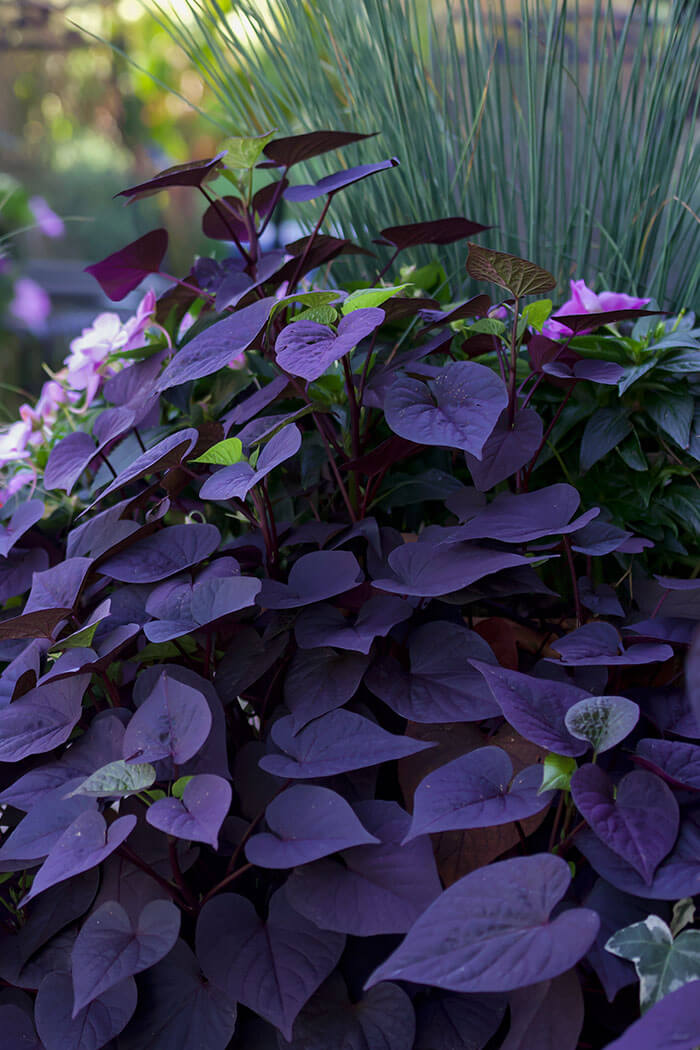
An ornamental sweet potato might not sound like the most exciting houseplant in the world, but these attractive vines are much more than a source of edible tubers. They’re in the same genus as morning glories (though not related to potatoes), and their foliage is amazingly variable: young leaves are heart-shaped, but they become deeply lobed as they grow, ultimately looking more like dragonflies or ornamental ironwork than leaves!
Sweet potato is often grown as a groundcover because of its tolerance for heat and humidity, but it takes just as well to containers, cascading from its pot like a fountain of foliage! A number of varieties offer striking shades of purple and maroon, from ‘Sweet Caroline Red’ to ‘Sidekick Black,’ so dark that it looks – well, black. Because of their large tubers, sweet potatoes are vulnerable to root rot, so make sure your plants are well-drained. Oh, and you can eat those tubers too: try them with some purple basil!
13. Mona Lavender (Plectranthus ‘Mona Lavender’)
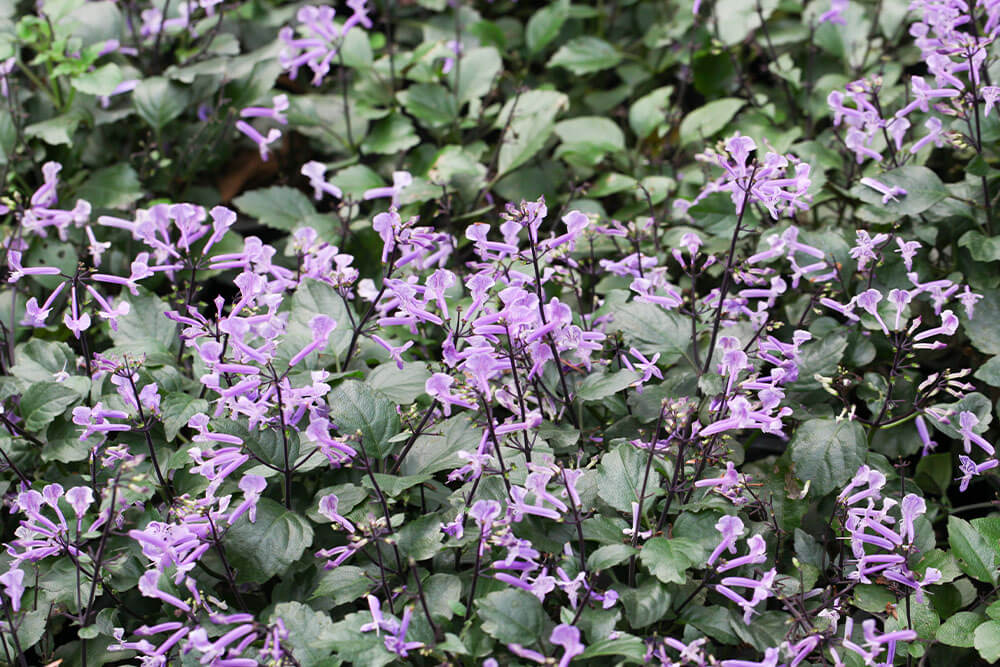
If all Mona lavender had going for it was its glossy, evergreen foliage and delicate purple sage-like flowers, it would still be worth having around – but look closer at those leaves, and you’ll notice that they’re actually bright purple underneath! The color is caused by fine, velvety hairs, similar to Persian shields – you might call it “business on top, party underneath”! The profuse lavender-colored flowers perfectly offset the lush green foliage while complementing the “secret” purple of the leaves.
Mona lavender isn’t actually all that closely related to lavender, but it’s in the same family (the mint family, Lamiaceae). It tolerates full shade, which makes it a great choice for a houseplant, and it has a unique blooming schedule that makes it ideal for indoor gardening: it starts flowering in the fall and can bloom right through to spring, adding some cheer even in the depths of winter.
14. Boat Lily (Tradescantia spathacea)
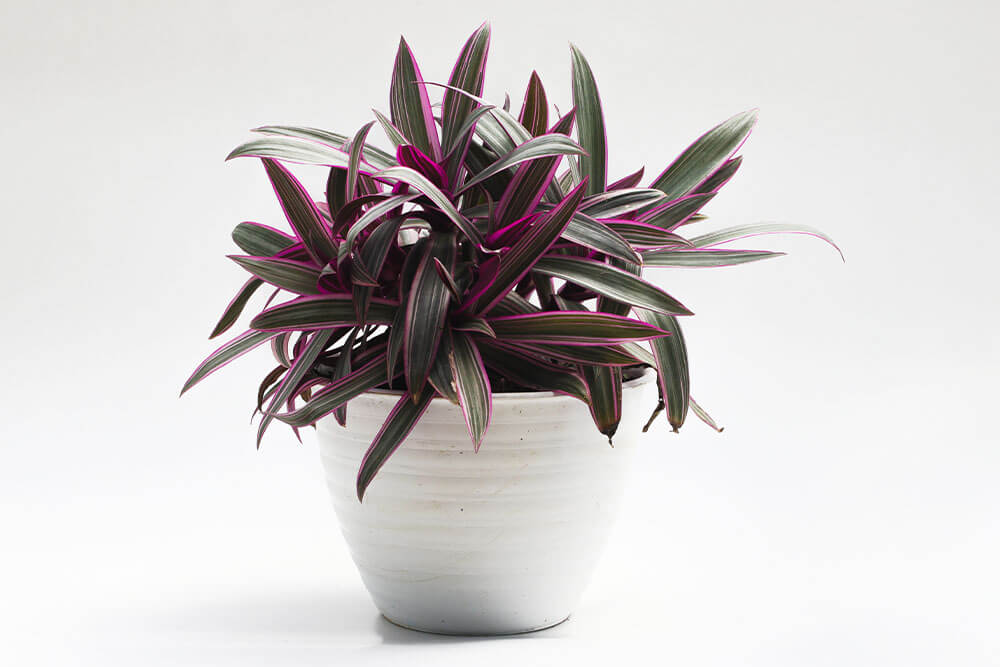
Boat lily, also called Moses-in-the-cradle, isn’t actually a lily: it’s closely related to purple heart (see above), and the green-and-purple variegated foliage will probably remind you of that plant. However, boat lily is a much tidier plant than purple heart, mostly sticking to an upright, clumping rosette of large sword-like leaves.
One thing it definitely shares with purple heart is ease of cultivation: it will grow in just about any soil or light environment (though bright filtered light yields the most colorful foliage) and is exceptionally resistant to pests and disease. If you like a more “overflowing” look, try planting it in a hanging planter. If you prefer something more compact, just clip any “runners” that emerge from the central rosette: like purple heart, they’re easy to propagate.
15. (Echeveria ‘Purple Pearl’)
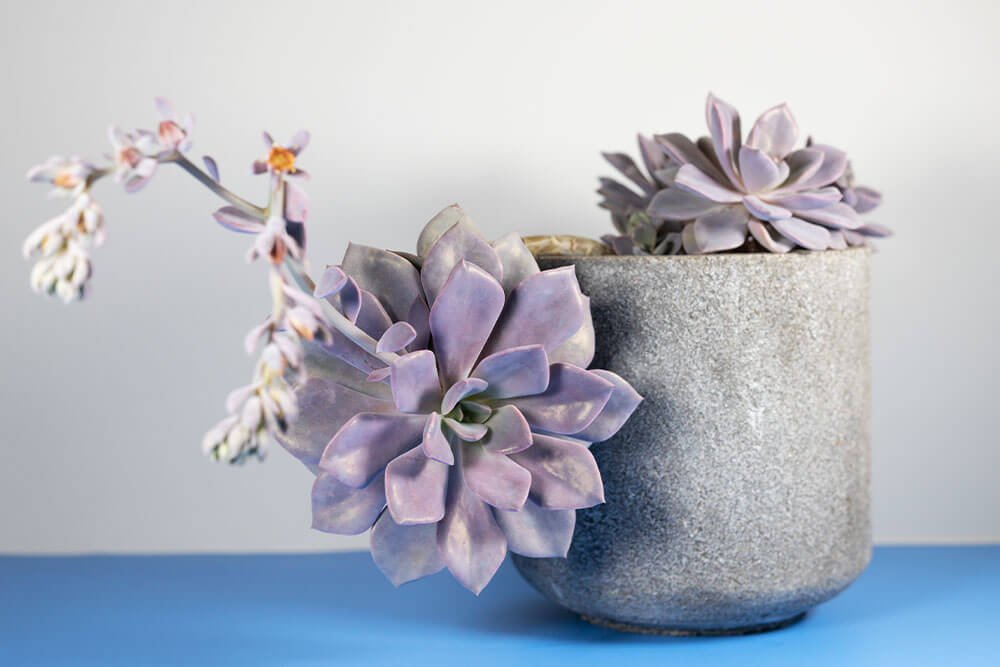
Echeverias are some of the most popular succulent houseplants – admittedly, that’s probably partly because they don’t have spines or thorns like 90% of succulents, but their fleshy leaves are still unique and quite beautiful. They’re sometimes called “desert roses” because of their flower-like appearance, and range from the tiny ‘hens and chicks’ varieties to real monsters a foot in diameter and height!
‘Purple Pearl’ echeveria is definitely in the latter category, and in addition to being big it’s also a vibrant purple that really stands out. Like many succulents, it doesn’t do well in low light: it’ll survive, but the foliage won’t be as vibrant. In full sun, it will not only produce the most richly colored leaves, but if you’re lucky, flowers as well! Echeveria’s flowers aren’t the showiest, but they’re quite striking, emerging from the center of the rosette on spindly spikes, almost like coral bells (Heuchera).
16. Caladium, Angel’s Wings (Caladium bicolor ‘Va Va Violet’)
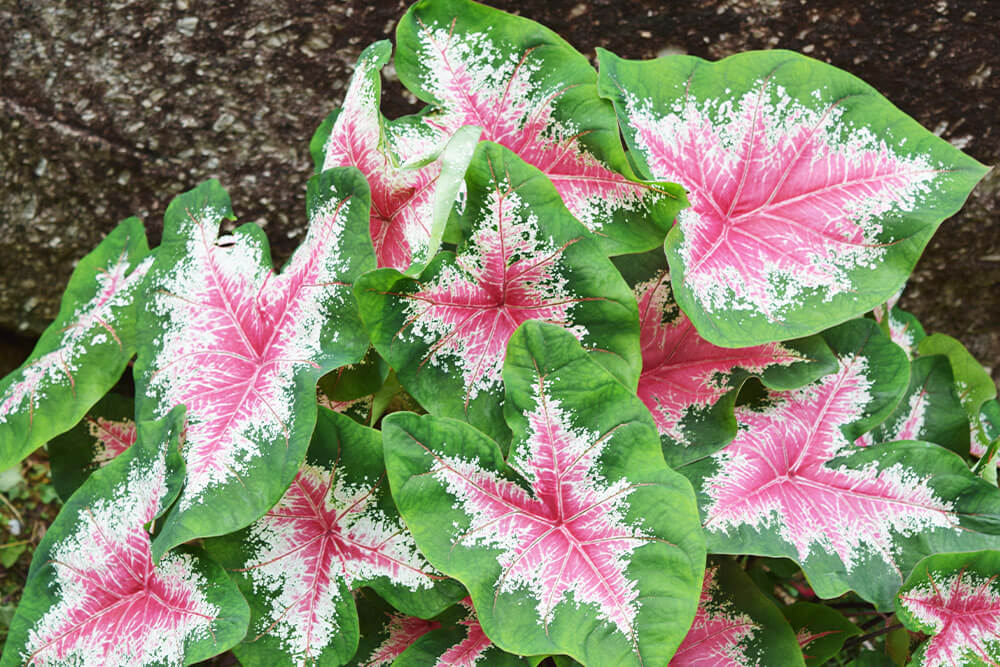
Whether you call it angel’s wings, elephant’s ears, or heart of Jesus, caladium is a real show-stopper of an ornamental. Its foliage is spectacular, coming in mottled shades of green, red, pink, white, and even polka-dotted. Perhaps the most beautiful of all, though, is the ‘Va Va Violet,’ which boasts huge pink-and-purple leaves edged in dark green.
Caladiums are grown from bulbs (technically tubers), just like lilies and irises, and in fact they’re in the same family as calla lilies. They grow equally well in shaded gardens and indoors: bright morning light with afternoon shade gives the best foliage colors, and regular watering will keep those leaves standing tall. Whether in-ground or in pots, these are some truly “angelic” ornamentals!
17. Calathea (Goeppertia roseopicta ‘Dottie’)
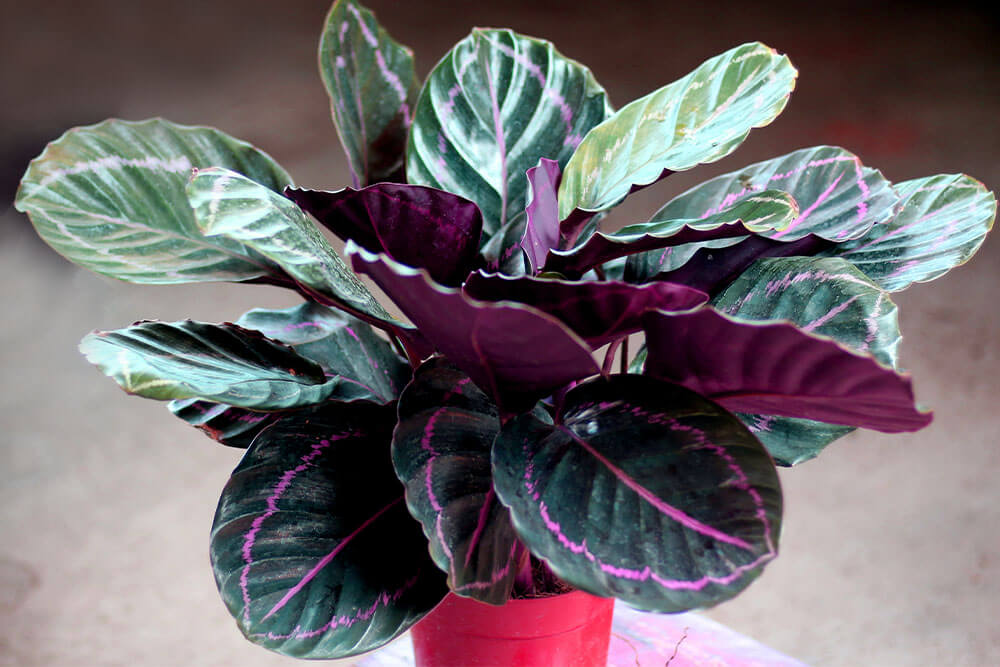
If you prefer your purple foliage subtle and tasteful, calathea ‘Dottie’ may be just what you’re looking for. Calatheas are known for their intriguing foliage, and ‘Dottie’ is no exception: the large, glossy leaves are dark green, similar to a rubber plant, but with a twist: two loud pink or purple stripes running right down the middle of each leaf. Somehow the effect is even more striking than an all-purple plant, and looks even more unreal.
One challenge of growing calatheas is making sure they get enough water (they need to be misted daily to stay humid), but not so much that the leaves turn yellow and drop off. Find a location with good light, then experiment a little with watering: a short dry spell won’t hurt the plant, and will give you an idea of how frequently it needs to be watered. Once you’ve got that figured out, it’s a very low-maintenance plant!
18. Stonecrop (Sedum ‘Purple Emperor’)
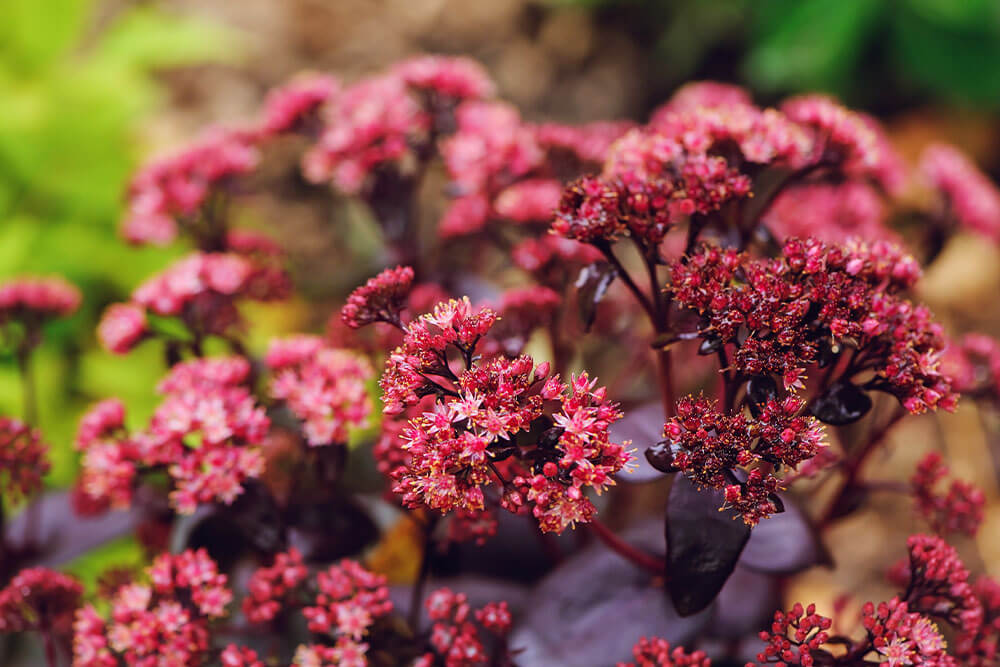
Stonecrops are part of an extraordinarily diverse genus of over 400 succulent, creeping plants, mostly native to North and South America. Gardeners love them both for their hardiness and their aesthetic appeal, but a number of varieties make great indoor plants as well. The ‘Purple Emperor’ hybrid stonecrop is one of the taller varieties, reaching a foot tall or more and spreading slowly from a central clump. Its succulent, dusky purple foliage is complemented by large clusters of pink flowers that last for months in late summer!
‘Purple Emperor’ (and stonecrops in general) does best in bright, filtered light, though direct sunlight is fine too. Too much shade will cause the plant to etiolate, or grow long, floppy stems in an attempt to reach sunlight – not attractive! More sun will also lead to more flowers and richer foliage. Like a lot of ornamental succulents, it’s quite tolerant of dry and/or infertile soil (in fact, overly fertile soil can lead to the same problems as shade), and would make a great addition to a miniature rock garden.
19. Ti Plant (Cordyline fruticosa)
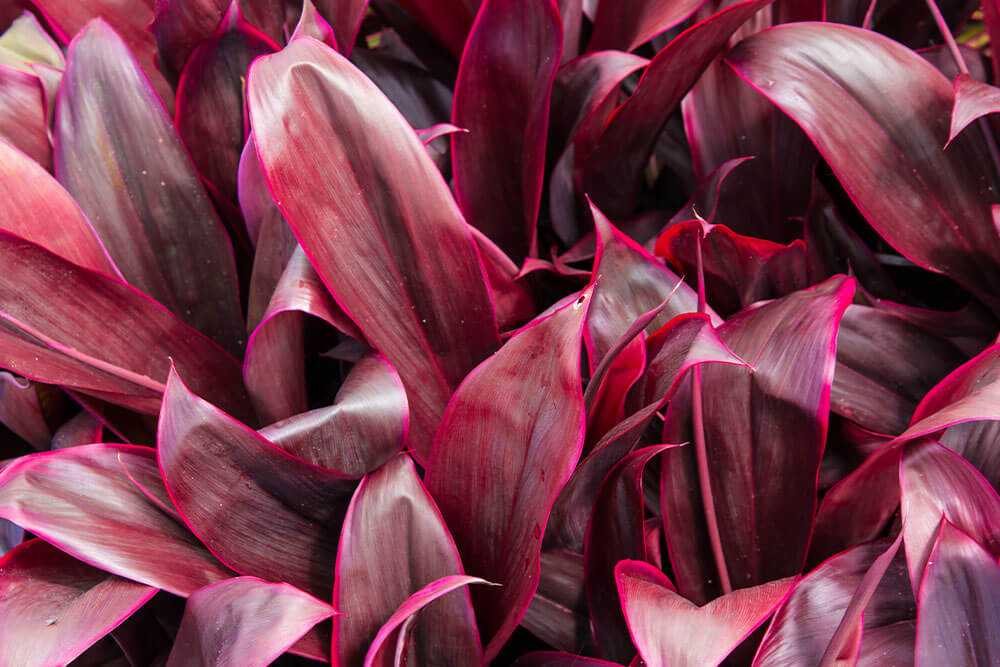
Ti plant might be best known as the source of leaves for traditional Hawaiian “grass” skirts (it’s actually in the asparagus family), but it’s also an attractive, low-maintenance houseplant that boasts deep green foliage tinged with pinks, reds, and purples. The ‘Soledad Purple’ and ‘Purple Prince’ cultivars both feature vivid magenta leaves that fade to a variegated purple and green as they age; like many plants on this list, bright filtered light will yield the best colors.
Ti plant is often confused with dracaena, which isn’t that much of a problem since they have similar care requirements. It needs consistent soil humidity, which is easy to achieve with a saucer filled with rocks and water; otherwise, you only need to water it when the top of the soil dries out. Like some other houseplants, this plant is sensitive to fluoride, so if your tap water is fluoridated you may want to water it with distilled water instead.
19 Gorgeous Purple Leaf Houseplants Featuring Stunning Foliage
Purple foliage can give a plant a striking and even somewhat unreal appearance – but it’s actually not that uncommon in the plant kingdom. The plants above are just a few of the many houseplants that boast vibrant violet leaves! These plants are great because their color gives you a hint on their care: purple leaves means bright, indirect light. Give these plants plenty of light and a little care and they’ll impress for years to come!
Frequently Asked Questions About Purple Leaf Indoor Plants
What houseplants have purple leaves?
This list doesn’t include every houseplant with purple leaves, but it does include the most popular. Of the plants on this list, the most vivid are Persian shields, Velvet plant, and Purple heart.
What indoor plant is purple?
All of the plants above can be grown indoors, and all of them are purple! Most purple plants with some shade tolerance can be grown as indoor plants, and even full sun plants can be grown indoors if you have a sunny enough place to put them. If you don’t, you can keep them outside in spring and summer, bringing them in in fall when they’re not photosynthesizing as much and don’t need as much light.
What causes purple leaves on plants?
Purple leaves are caused by the accumulation of anthocyanins, pigments that protect the leaves from sun damage and herbivory. Some plants produce these pigments as an adaptation to a high light environment, but purple spots can also indicate a deficiency in phosphorus.
What deficiency causes purple leaves?
In some plants, phosphorus deficiency leads to purple spotting on the leaves, especially the lower leaves. This is different from normal purple coloring, although the chemicals involved are the same: without going too deeply into the biochemistry, the chemicals involved in signaling phosphorus deficiency and producing anthocyanins are structurally similar, so phosphorus starvation can lead to overproduction of anthocyanins.
What nutrient turns plants purple?
The pigments that cause purple coloring in leaves (as well as fruits like blackberries and blueberries) are called anthocyanins, and many are powerful antioxidants — meaning they’re good for humans as well as plants. Purple coloring can also indicate a lack of nutrients, namely phosphorus. The cause is the same — anthocyanins — but in this case, the accumulation of anthocyanins is a “malfunction” caused by phosphorus starvation.


